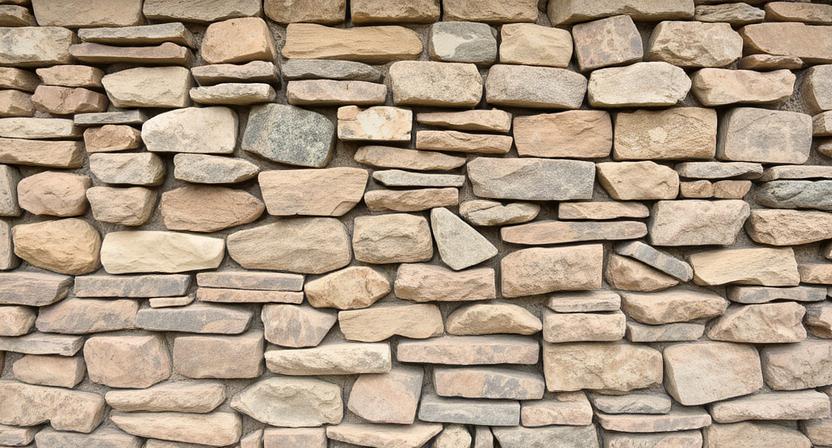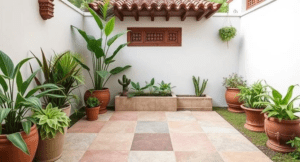Random rubble masonry is one of the oldest and most widely used forms of stone construction. It’s commonly seen in boundary walls, rural houses, retaining walls, and even in heritage buildings. In this blog, we’ll explore what random rubble masonry is, its types, benefits, materials, specifications, cost, and how it compares with coursed rubble masonry.
What is Random Rubble Masonry?
Random rubble masonry is a type of stone construction where undressed or roughly dressed stones of irregular shapes and sizes are laid without a uniform pattern. The stones are arranged randomly, and spaces between larger stones are filled with smaller stones or mortar.
It is often used in rural and low-cost construction because it’s durable, strong, and relatively inexpensive compared to other types of masonry.
Types of Random Rubble Masonry
Random rubble masonry is divided into different types based on how the stones are arranged and whether mortar is used. Each type has its own features and ideal uses.
1. Uncoursed Random Rubble Masonry
In this type, stones are laid without any particular pattern. They are placed in a completely random and unorganized manner, using stones of different sizes and shapes.
No layering is followed the stones are not arranged in horizontal courses.
It looks rough and irregular but is strong enough for simple structures.
Commonly used in rural areas or for temporary and low-cost buildings where appearance is not very important.
This is the most basic and economical form of rubble masonry.
2. Coursed Random Rubble Masonry
In this type, an effort is made to arrange the stones in rough horizontal layers, also known as courses.
The stones are still irregular, but masons try to keep the top surface of each stone roughly aligned.
It looks more organized and neater than uncoursed work.
Often used in residential buildings, compound walls, or structures where looks matter.
This type offers a balance between natural stone appearance and a more finished look.
3. Dry Random Rubble Masonry
As the name suggests, this method does not use mortar to bind the stones. Instead, the stones are carefully selected and stacked tightly together so they stay in place using gravity and friction.
Since there’s no mortar, accurate stone placement is critical.
This method is highly skilled, as the stability depends on how well the stones fit.
It is mostly used for retaining walls, boundary walls, or temporary structures.
It’s also a more eco-friendly option as it avoids cement or lime mortar.
Dry random rubble masonry is strong and flexible, especially useful where drainage is needed, such as in landscaping or hillside construction.
Materials Used in Random Rubble Masonry
Random rubble masonry relies on natural stone and basic construction materials. The selection of materials plays a key role in the strength, durability, and appearance of the masonry work.
1. Stones
The most important material in random rubble masonry is stone. Since the stones are not finely shaped or polished, they should be naturally strong and hard.
Commonly used stones include:
Granite – Extremely hard and durable, suitable for foundations and retaining walls.
Basalt – Dark-colored, tough stone that’s often used in road and drainage construction.
Limestone – Easy to work with and gives a clean, light appearance.
Sandstone – Available in different colors and relatively easier to shape.
Locally available stones – Many projects use stones found near the site to reduce cost and transportation effort.
The choice of stone depends on local availability, project needs, and budget.
2. Mortar
Mortar is the binding material used to hold the stones together in place. It fills gaps between irregular stones and helps in leveling them.
Types of mortar used:
Cement mortar – A mixture of cement and sand, commonly used for stronger and more durable construction.
Lime mortar – Made from lime and sand, often used in heritage structures or where breathability is needed.
No mortar – In dry rubble masonry, mortar is not used at all. Instead, stones are tightly packed by hand for stability.
The choice of mortar depends on the type of structure and the desired durability.
3. Tools
Although the stones are not finely cut, some tools are needed for shaping and fitting them properly.
Common tools used:
Hammer – Used for breaking or shaping stones to fit into place.
Chisel – Helps in trimming rough edges and adjusting stone size.
Measuring tools – Like plumb bobs, strings, or levels to keep the wall aligned and vertical.
Skilled workers use these tools to place the stones correctly and ensure the wall is stable and visually acceptable.
Benefits of Random Rubble Masonry
Random rubble masonry is a popular construction method, especially in rural and semi-urban areas. It offers several advantages, both in terms of strength and cost. Here’s a closer look at its key benefits:
1. Cost-Effective
One of the biggest advantages of random rubble masonry is its affordability. It uses locally available natural stones, which reduces transportation and material costs. Since the stones are used in their natural or roughly dressed form, no expensive finishing or polishing is required. The use of simple tools and low-cost labor makes this method an economical option for boundary walls, foundations, and retaining structures.
2. Strong and Durable
Random rubble masonry is known for its structural strength. The irregular stones, when fitted properly and bonded with mortar, create a tough and stable wall. It can easily bear heavy loads, making it suitable for foundations and load-bearing walls in small buildings. In dry rubble masonry, the tightly packed stones can also resist soil pressure, making it ideal for retaining walls.
3. Traditional and Rustic Look
This type of masonry adds a natural, rustic appearance to buildings and landscapes. The uneven texture of the stones gives a traditional and earthy charm, often preferred in countryside homes, heritage buildings, garden walls, and rural resorts. It blends well with natural surroundings and adds character to outdoor spaces.
4. Low Maintenance
Structures built with random rubble masonry require minimal upkeep. The natural stones are highly resistant to weather changes, moisture, and erosion, which means the walls can last for years without cracking or fading. In areas with heavy rainfall or harsh climates, it performs well with very little repair work needed over time.
Advantages of Random Rubble Masonry
1. Suitable for Areas Where Skilled Labor Is Limited
Random rubble masonry doesn’t require highly skilled stone masons for basic work. Since the stones are used in their natural or roughly shaped form, general construction workers can carry out the work with some basic training. This makes it ideal for remote or rural areas where expert labor might not be available.
2. Makes Use of Naturally Available Stones
This method often uses locally sourced stones, which are readily available in many regions. By using stones found near the construction site, transportation costs are reduced, and construction becomes more sustainable. This also supports the use of regional materials suited to the local climate and environment.
3. Strong Enough for Boundary and Retaining Walls
When properly constructed, random rubble masonry is strong and stable, making it perfect for boundary walls, compound walls, and retaining structures. The rough texture of the stones helps in creating a good bond with mortar, contributing to the wall’s strength and load-bearing capacity.
4. Eco-Friendly When Using Locally Sourced Materials
By using natural and local materials, random rubble masonry has a low environmental impact. It avoids the need for manufactured bricks or heavy machinery, making it a sustainable choice. Especially in dry rubble masonry, where no cement or lime is used, the method becomes even more environmentally friendly.
Disadvantages of Random Rubble Masonry
1. Irregular Shape of Stones Makes Construction Slow
Since the stones are of different shapes and sizes, workers need to spend extra time selecting and fitting them together. Unlike brickwork or shaped stone masonry, there’s no uniformity, which slows down the construction process and requires more effort.
2. Requires More Mortar Compared to Shaped Stone Masonry
The uneven surfaces and gaps between the irregular stones often mean that more mortar is needed to fill voids and create a stable structure. This increases material consumption and can slightly raise the overall construction cost, especially if cement mortar is used.
3. Appearance May Not Be Very Neat Unless Well-Constructed
If not done carefully, random rubble masonry can look rough and untidy. Uneven joints, visible mortar lines, and poor stone arrangement can affect the visual quality. For a cleaner finish, extra attention is needed during construction.
4. Needs Skilled Workers to Select and Fit Stones Properly
Although high-level skill is not always required, experienced hands are needed to choose the right stones and place them properly so that the wall remains strong and aligned. A lack of skill can lead to weak spots, poor bonding, and even structural issues over time.
Applications of Random Rubble Masonry
Random rubble masonry is used in various types of construction, especially where cost-effectiveness, strength, and a natural look are required. Some common applications include:
1. Compound and Boundary Walls
Random rubble masonry is ideal for building low-cost and durable boundary walls around homes, farms, or public properties. Its natural strength helps resist weather and wear over time.
2. Retaining Walls for Roads or Gardens
Due to its strong structure and weight, it is used in retaining walls that hold back soil on sloped land, such as along highways, garden beds, or terraces.
3. Foundations in Low-Cost Buildings
In rural or budget-friendly construction, it is used in building foundations where high-cost concrete or brickwork may not be affordable. It provides a strong base for small structures.
4. Landscaping and Decorative Walls
Random rubble masonry gives a rustic and natural appearance, making it a popular choice in landscaping, garden edging, and decorative outdoor walls.
5. Historical and Restoration Works
Many heritage structures and traditional buildings use random rubble masonry. It is still used in restoration projects to maintain the original look and materials.
Random Rubble Masonry Specification
Proper construction requires meeting certain technical guidelines to ensure strength and stability. Here are the key specifications:
1. Stone Size
Large stones are placed at the corners and base for extra strength.
Smaller stones are used to fill gaps between larger stones, improving compactness and reducing mortar usage.
2. Mortar Ratio
A standard cement mortar mix of 1:6 (1 part cement, 6 parts sand) is commonly used.
In some cases, lime mortar may be used for heritage or breathable walls.
3. Joint Thickness
Mortar joints should be no thicker than 20 mm, ensuring tight bonding between stones and reducing weak spots.
4. Wall Thickness
The wall should have a minimum thickness of 35 cm to support its own weight and external loads, especially in retaining or compound walls.
5. Bonding (Through Stones)
Through stones, also called bond stones, are placed at regular intervals to connect the outer and inner parts of the wall, improving overall stability.
Random Rubble Masonry Cost
Material cost: Depends on local stone availability. Using nearby stones reduces cost.
Labor cost: Varies by region and type (dry or mortar-based).
Average rate in India:
₹600 to ₹900 per cubic meter for dry rubble.
₹1,000 to ₹1,500 per cubic meter for mortar-based rubble masonry.
Prices may change based on design, height, and location.
Random Rubble Masonry vs. Coursed Rubble Masonry
| Feature | Random Rubble Masonry | Coursed Rubble Masonry |
|---|---|---|
| Stone arrangement | Irregular, unpatterned | Arranged in layers (courses) |
| Appearance | Rustic and rough | Neater and more uniform |
| Construction skill needed | Less, but requires care | Higher skill required |
| Strength | Good for basic needs | Better strength and load-bearing capacity |
| Cost | Lower due to rough stones | Higher due to shaping and labor |
| Use cases | Boundary walls, rural homes | Buildings, compound walls, aesthetic use |
Conclusion
Random rubble masonry is a practical, economical, and time-tested method of stone construction, especially suitable for rural areas or structures where appearance is not the top priority. Its strength, cost-effectiveness, and availability of materials make it ideal for boundary walls, retaining walls, and even foundations.
If constructed carefully with proper bonding and mortar, it can last for decades with very little maintenance.
Build Strong, Beautiful Structures with SmartScale
Looking to build a durable boundary wall, retaining wall, or foundation using random rubble masonry? At SmartScale House Design, we offer expert planning, material guidance, and cost-effective solutions tailored to your site and budget.
Get in touch today for personalized support, accurate designs, and quality construction backed by experience and trust.
FAQs
1. What is a random rubble masonry?
Random rubble masonry is a type of stone construction where irregular-shaped stones are placed together in a non-uniform pattern to build walls. The stones are typically undressed or roughly dressed and are either laid with mortar (wet masonry) or without mortar (dry masonry). It is commonly used for boundary walls, retaining walls, and rural buildings due to its strength and cost-effectiveness.
2. What is random rubble stone masonry?
Random rubble stone masonry refers to the same technique where natural or roughly cut stones are laid randomly, without any fixed alignment or size. The word “stone” emphasizes the use of natural stones such as granite, basalt, sandstone, or limestone. It is one of the simplest and oldest methods of stone construction.
3. What size is random rubble masonry?
There is no fixed size for the stones used in random rubble masonry. However:
-
Larger stones are used at corners and base levels for strength.
-
Smaller stones are used to fill gaps between larger stones.
-
Wall thickness is usually not less than 35 cm for stability.
-
Mortar joints should ideally be less than 20 mm thick.
The overall size of the masonry structure depends on its purpose and design.
4. Where is random rubble masonry used?
Random rubble masonry is used in a variety of construction projects, especially where low-cost, strong, and durable walls are needed:
-
Boundary and compound walls
-
Retaining walls for soil support
-
Foundations of small buildings
-
Garden walls and landscaping
-
Rural or traditional homes
-
Restoration of heritage structures
5. What is the ratio for random rubble masonry?
The mortar mix ratio commonly used in random rubble masonry is:
-
1:6 – One part cement and six parts sand (for general use)
-
1:4 – For stronger walls or wet areas
-
Lime mortar (1:2 to 1:3) – Used in heritage or breathable constructions
In dry rubble masonry, no mortar is used; stones are tightly packed without binding material.
6. How to calculate a masonry wall?
To calculate the volume of a masonry wall, use this simple formula:
Volume = Length × Height × Thickness
Example:
If a wall is 10 meters long, 2 meters high, and 0.35 meters thick:
Volume = 10 × 2 × 0.35 = 7 cubic meters
This volume is used to estimate the quantity of stone and mortar needed and helps in cost estimation for construction.








